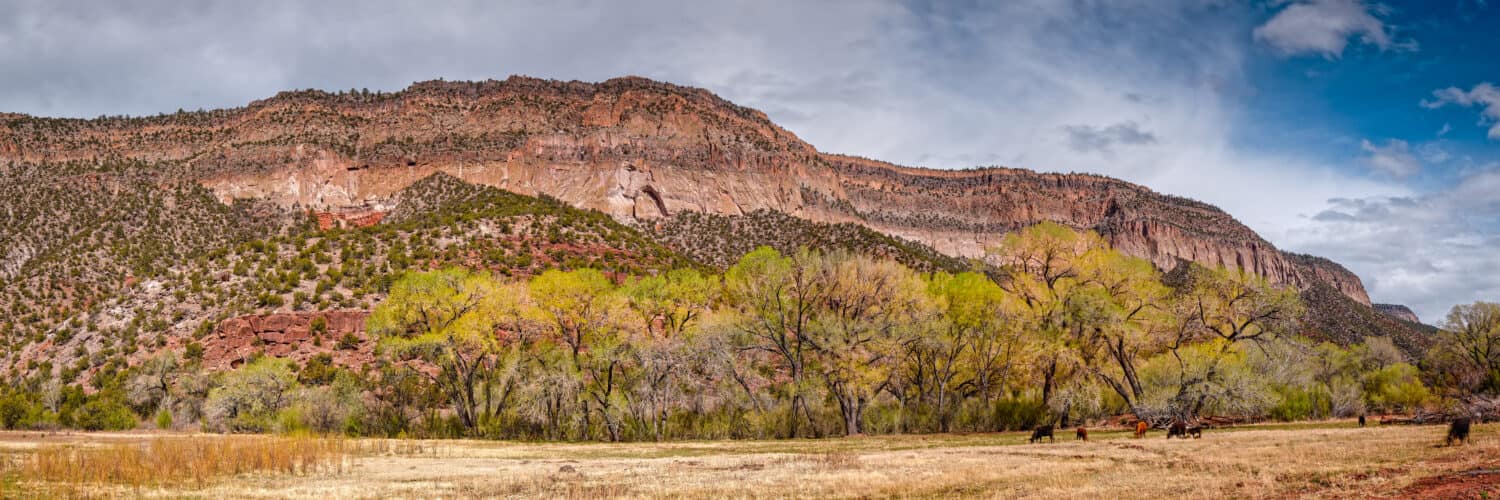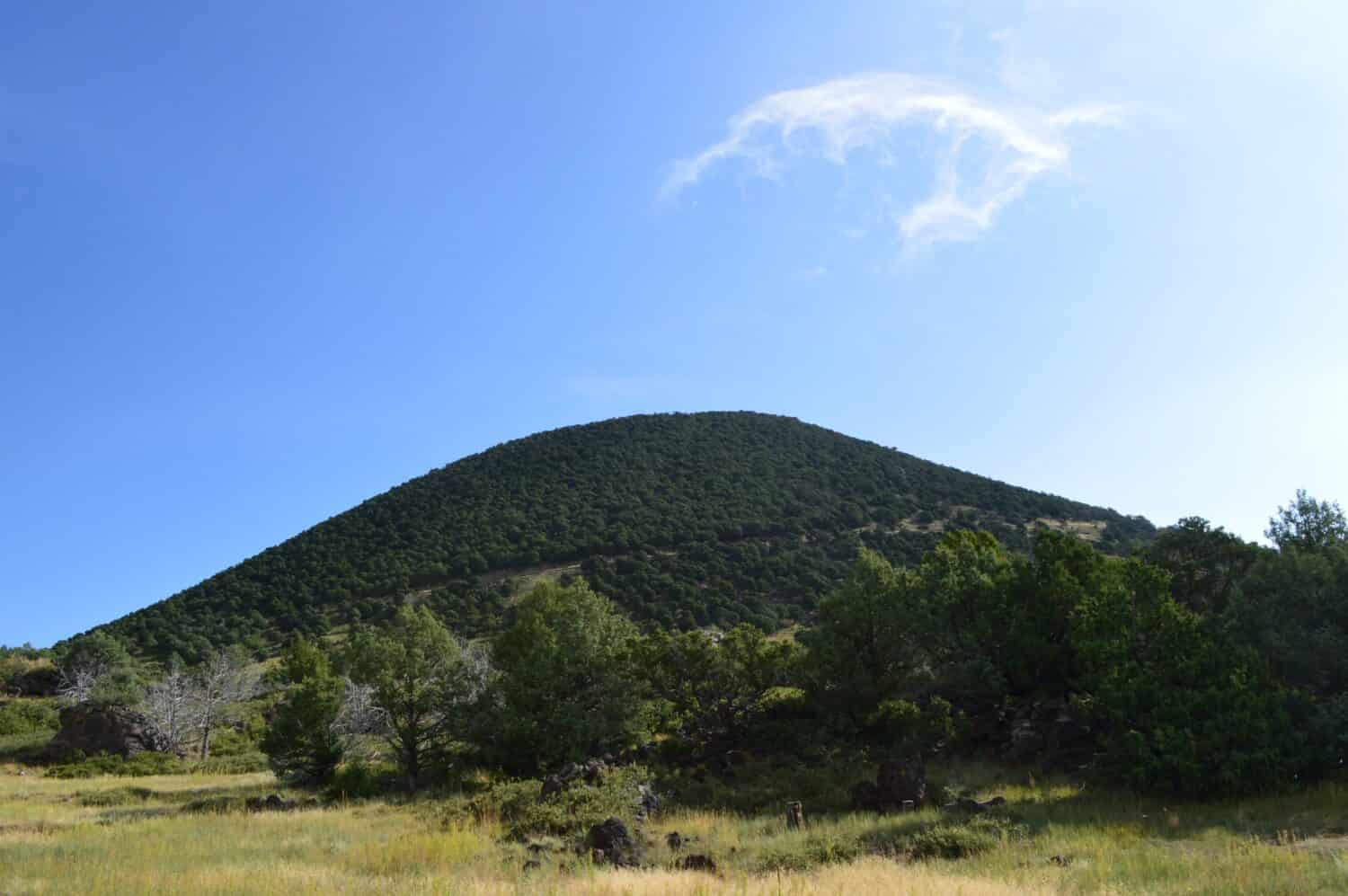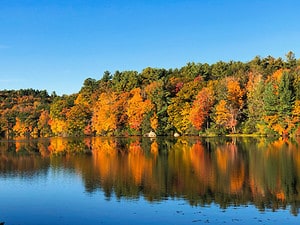Of all the aspects that set New Mexico apart from other states, the abundance of volcanoes often flies under the radar. Surprisingly, the Land of Enchantment has a complex geologic history. It is home to a variety of volcanic features, ranging from cinder cones to supervolcanoes. In this article, we delve into three of the largest and most notable volcanoes in New Mexico. Each one is unique and rich in geological history.
Are you ready to explore the most striking natural formations in the state? Dive into these fascinating snapshots of New Mexico’s volcanic past!

1. Valles Caldera

The scenic views of Jemez Springs Red Cliffs and Cottonwoods are beautiful.
©Silvio Ligutti/Shutterstock.com
Valles Caldera is a volcanic caldera located in Northern New Mexico. It is the oldest of three young caldera-type volcanoes in the area. It is also one of the largest young calderas on Earth.
Location and Size
The Valles Caldera is located in the Jemez Mountains of northern New Mexico. It is about 13.7 miles (22 km) wide and is the world’s type example of a resurgent caldera.
Formation and Composition
The eruption that created the Valles Caldera occurred approximately 1.25 million years ago. It is the largest of three young caldera-type vents. It formed during the last two million years within the Jemez Volcanic Field.
The caldera is associated with a number of other volcanic features. These include a number of small andesitic domes, lava flows, and hot springs. The rocks at Valles Caldera range in age from 14 million years old to less than 50,000 years old. The unusual geology and beautiful scenery of the Valles Caldera have made it a popular tourist destination and research site.
A caldera is a large depression in the Earth’s surface. It forms when a volcano erupts and its magma chamber empties, causing the ground above to collapse. Calderas can be several kilometers across and can form in a variety of geological settings, from shield volcanoes to stratovolcanoes. Calderas are often associated with supervolcanoes. These volcanoes are capable of producing massive eruptions with an ejecta volume greater than 1,000 cubic kilometers.
Classification
The eruption that created the Valles Caldera is similar to Yellowstone in terms of its classification as a supervolcano. Valles Caldera, one of the largest young calderas on Earth, is in the Jemez Volcanic Field.
Super volcanoes have an ejecta volume thousands of times greater than the volume of an average volcano. The term “supervolcano” is used to describe only the most massive and explosive types of volcanic eruptions. Super volcanoes have an eruption of magnitude 8 or more on the Volcano Explosivity Index (VEI). This is the largest recorded value on the index.
The largest supervolcanic eruptions are often associated with caldera-forming events. The overlying land and any magma chamber beneath come in contact with massive explosive or eruptive energy. This can reshape landscapes and leave long-lasting geological signals, such as vast ash deposits and volcanic debris.
Eruption History and Magnitude
the Valles Caldera has had two large-volume eruptions that created the widespread Bandelier Tuff ignimbrite plateaus. The size and magnitude of the eruption are not explicitly documented.
2. Mogollon-Datil Volcanic Field

The Mogollon-Datil volcanic field is large and covers much of the Datil-Mogollon region.
The Mogollon-Datil volcanic field is one of the largest concentrations of supervolcanoes on Earth. It is a volcanic field located in the western part of New Mexico.
Location and Size
The region is part of the larger Colorado Plateau province, which has extensive uplift, erosion, and volcanic activity. The region is also part of the larger Intermontane Plateaus, a physiographic section of the western United States. The Mogollon-Datil volcanic field is large (40,000 square kilometers (15,000 sq mi). It covers much of the Datil-Mogollon region, as well as adjacent areas of Arizona and Mexico.
Formation and Composition
Volcanic activity in the Mogollon-Datil volcanic field occurred during the Tertiary period. This was 40 to 24 million years ago. It produced enormous volumes of tuffs and other volcanic materials. The Datil-Mogollon Region includes many volcanic features, including andesite volcanoes, basaltic andesite volcanoes, and silicic calderas, described below:
Andesite volcanoes are steep and conical composite volcanoes. They are primarily composed of an intermediate volcanic rock called andesite. When magma from the mantle rises to the Earth’s surface, cools, and solidifies, it forms an andesite volcano. They can produce both explosive and effusive eruptions. Their eruptions can be quite violent because of the high viscosity of their magma. The magma that solidifies within the volcano leads to the gradual buildup of a stratovolcano over time.
Basaltic andesite is a type of volcanic rock that is intermediate in its composition between basalt and andesite. Basaltic andesite volcanoes feature dark gray to black volcanic rock. They are typically stratovolcanoes and are similar in shape and behavior to andesite volcanoes.
Silicic calderas are large volcanic craters that form due to the collapse of the Earth’s surface above a magma chamber composed of high-silica content magma. Explosive volcanic activity causes them. They can produce pyroclastic flows and ash deposits. The collapse creates a steep-walled depression, which may fill with water to form a lake. Silicic calderas are commonly in volcanic arcs that form above subduction zones.
Classification
The Mogollon-Datil volcanic field is an area of volcanic activity with a large concentration of calderas (large volcanic craters) and volcanic fields. Some of these calderas are supervolcanoes, although not all of the volcanic centers in the region meet the criteria for being a supervolcano. Therefore, the Datil-Mogollon Region has some supervolcanoes, but not all of them can be classified as supervolcanoes.
Eruption History and Magnitude
The volcanic field has had several significant eruptions throughout its history, including caldera-forming eruptions. The eruption history and magnitude of the Mogollon-Datil volcanic field may be studied through geochronology and thermal history modeling, but further information on specific events may require more targeted research.
3. Raton-Clayton Volcanic Field

This dormant volcano sits in Capulin Volcano NM.
©Her Merness/Shutterstock.com
The Raton-Clayton Volcanic Field (RCVF) is a large, young volcanic field in New Mexico. It contains over one hundred small volcanic vents, volcanoes, and lava flows.
Location and Size
The Raton-Clayton Volcanic Field (RCVF) covers nearly 7500-8000 square miles of northeastern New Mexico and adjoining Colorado and is the easternmost volcanic field in the United States. Capulin Volcano National Monument is located within the RCVF and serves as a popular tourist destination for viewing and exploring volcanic features.
Formation and Composition
The RCVF is a diverse range of volcanic landforms, including cinder cones, lava flows, and volcanic maars. The rocks and features of the RCVF provide important insights into the geologic and volcanic processes of the southwestern United States and are a subject of ongoing research and study.
Cinder cones, or scoria cones, are small hills of volcanic fragments such as cinders or scoria. They form when lava erupts explosively and solidifies in the air before falling to the ground, creating a cone-shaped pile of particles around the volcanic vent. They are less than 1,000 feet tall and are in groups, or volcanic fields. Cinder cones are the simplest type of volcano and are commonly associated with basaltic lava flows.
Volcanic maars are broad, low-relief volcanic craters where shallow explosive eruptions form. When lava comes into contact with groundwater, it causes a steam explosion that creates a crater in the ground, forming a volcanic maar. Water typically fills them, and they form a relatively shallow lake. Maars are low, wide craters that lie below the ground level among low pyroclastic cones. They are a type of phreatomagmatic volcano in volcanic fields around the world.
Classification
It is difficult to determine the exact classification of the volcanic rocks within the RCVF field beyond the general label of volcanic fields. While the Raton-Clayton Volcanic Field is an extensive volcanic field, it is relatively small in comparison to known supervolcanoes.
Eruption History and Magnitude
This volcanic field has erupted periodically since the late Cenozoic era and is still considered active. The most recent eruption occurred approximately 60,000 years ago. The largest eruption from the Raton-Clayton Volcanic Field likely had a magnitude of 6, which is a significantly smaller eruption than the eruptions of supervolcanoes.
In Conclusion
It is important to note that although Valles Caldera, the Datil-Mogollon region, and Raton-Clayton Volcanic Field are among the largest volcanic features in New Mexico, there may be other large volcanoes or volcanic fields in the state that are not as well-known or documented. To identify any additional large volcanic features in New Mexico, scientists need to conduct more research.
Summary of the Top 3 Largest Volcanoes in New Mexico
| Rank | Largest Volcano | Location |
|---|---|---|
| 1 | Western New Mexico | North central New Mexico |
| 2 | Mogollon-Datil Volcanic Field | western New Mexico |
| 3 | Raton-Clayton Volcanic Field | Northeastern New Mexico |
Thank you for reading! Have some feedback for us? Contact the AZ Animals editorial team.








